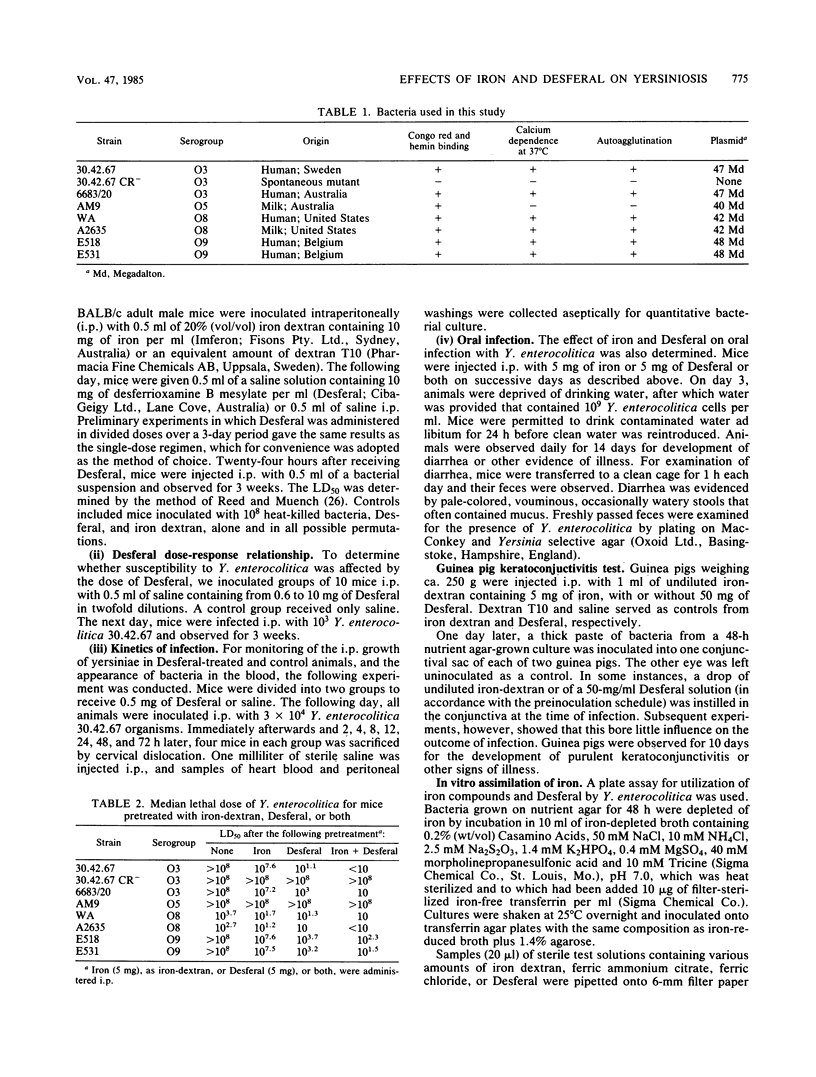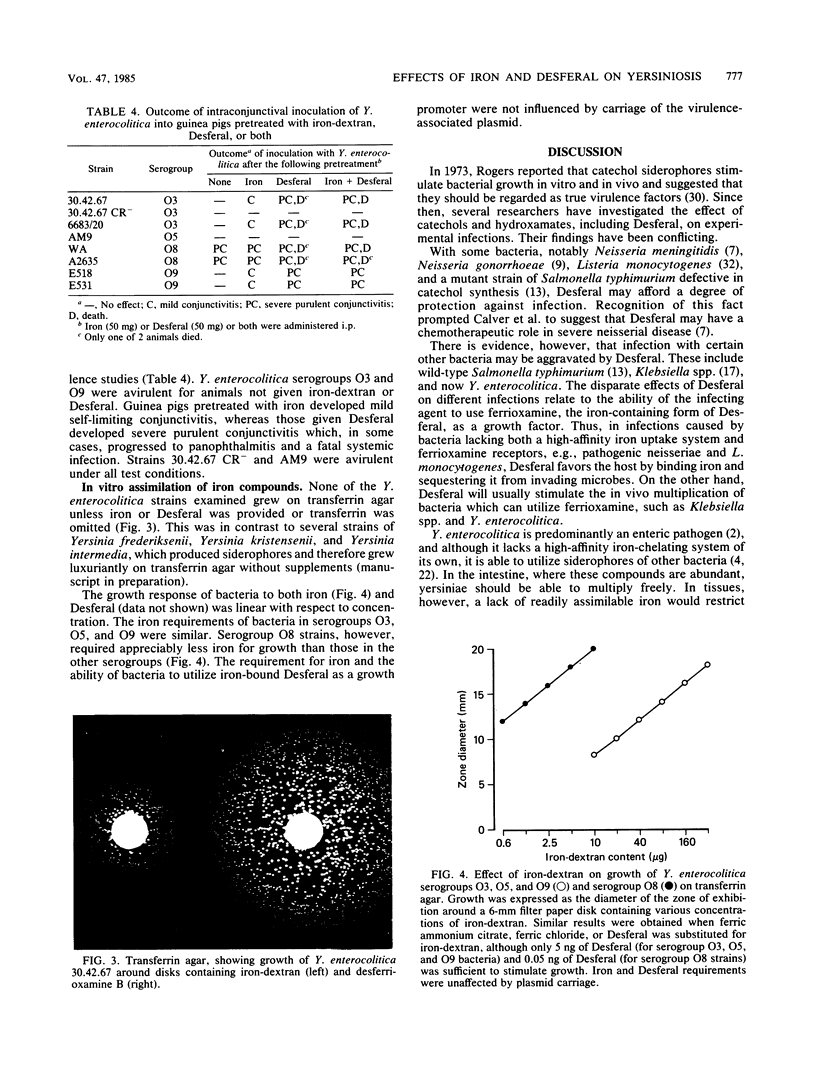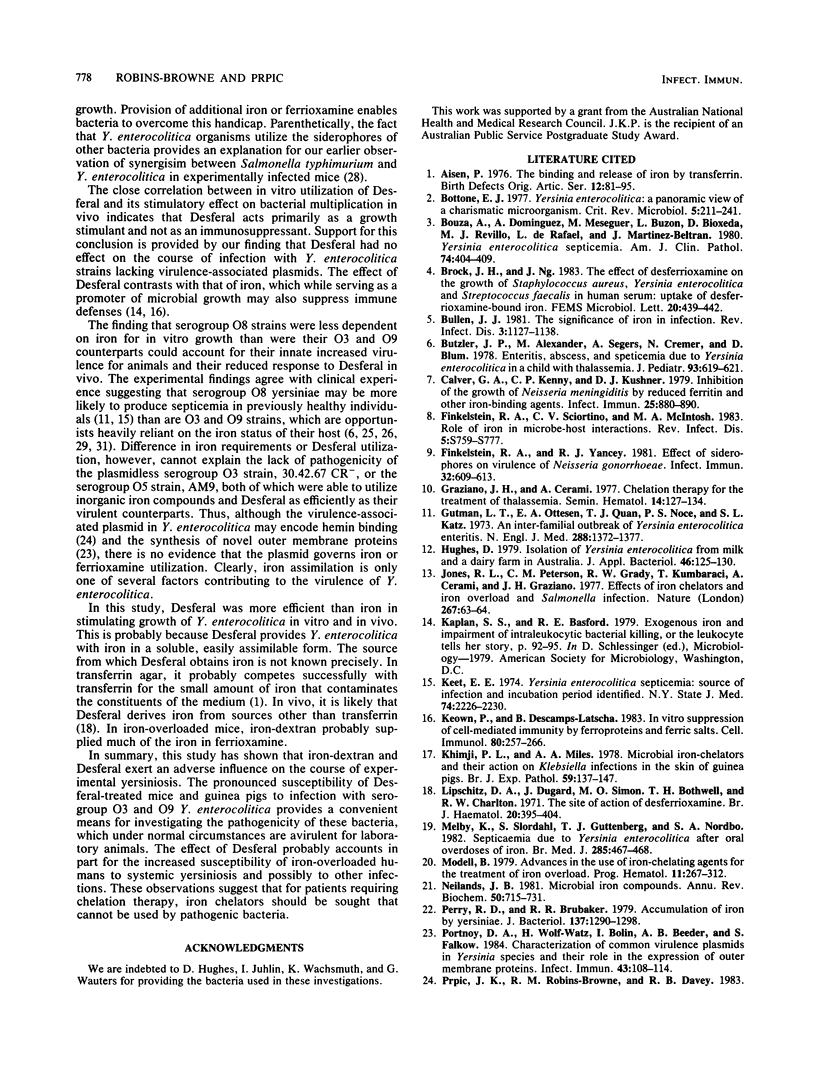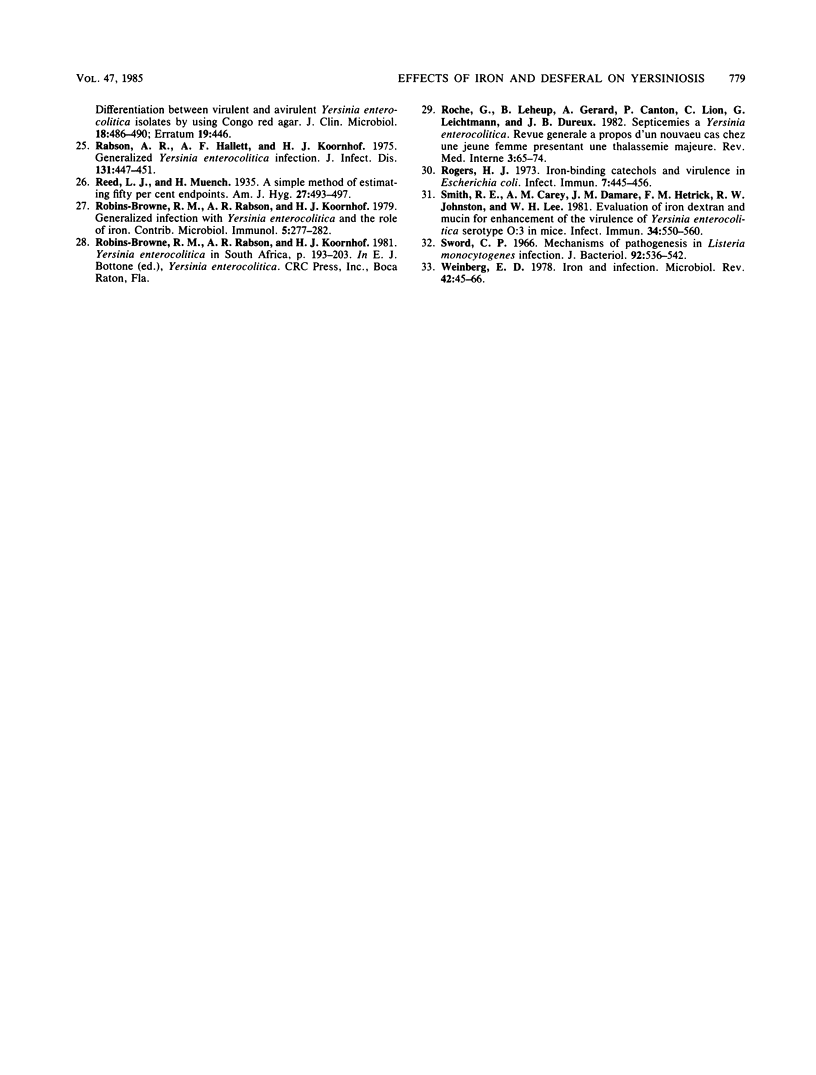Abstract
The effects of iron-dextran and the iron chelator desferrioxamine B mesylate (Desferal) on the course and outcome of experimental yersiniosis were investigated. Yersinia enterocolitica strains representing the three leading serogroups pathogenic for humans, O3, O8 and O9, were studied. In mice, iron-dextran reduced the median lethal dose of intraperitoneally administered Y. enterocolitica O3 and O9 ca. 10-fold, whereas Desferal reduced this value more than 100,000-fold. Experiments in which Y. enterocolitica was given orally to mice and intraconjunctivally to guinea pigs confirmed that Desferal markedly increased the susceptibility of animals to yersiniosis. Although serogroup O8 yersiniae were inherently more virulent for laboratory animals, they were less affected by Desferal than were O3 or O9 strains. In vitro experiments indicated that Desferal promoted growth of Y. enterocolitica under iron-limiting conditions and suggested that the enhanced virulence of O8 yersiniae may be due to their comparatively low requirement for iron. The adverse effect of Desferal on the course of experimental infection with Y. enterocolitica may partly explain the heightened susceptibility of iron-overloaded patients to systemic yersiniosis.
Full text
PDF





Images in this article
Selected References
These references are in PubMed. This may not be the complete list of references from this article.
- Aisen P. The binding and release of iron by transferrin. Birth Defects Orig Artic Ser. 1976;12(8):81–95. [PubMed] [Google Scholar]
- Bottone E. J. Yersinia enterocolitica: a panoramic view of a charismatic microorganism. CRC Crit Rev Microbiol. 1977;5(2):211–241. doi: 10.3109/10408417709102312. [DOI] [PubMed] [Google Scholar]
- Bouza E., Dominguez A., Meseguer M., Buzon L., Boixeda D., Revillo M. J., de Rafael L., Martinez-Beltran J. Yersinia enterocolitica Septicemia. Am J Clin Pathol. 1980 Oct;74(4):404–409. doi: 10.1093/ajcp/74.4.404. [DOI] [PubMed] [Google Scholar]
- Bullen J. J. The significance of iron in infection. Rev Infect Dis. 1981 Nov-Dec;3(6):1127–1138. doi: 10.1093/clinids/3.6.1127. [DOI] [PubMed] [Google Scholar]
- Butzler J. P., Alexander M., Segers A., Cremer N., Blum D. Enteritis, abscess, and septicemia due to Yersinia enterocolitica in a child with thalassemia. J Pediatr. 1978 Oct;93(4):619–621. doi: 10.1016/s0022-3476(78)80899-3. [DOI] [PubMed] [Google Scholar]
- Calver G. A., Kenny C. P., Kushner D. J. Inhibition of the growth of Neisseria meningitidis by reduced ferritin and other iron-binding agents. Infect Immun. 1979 Sep;25(3):880–890. doi: 10.1128/iai.25.3.880-890.1979. [DOI] [PMC free article] [PubMed] [Google Scholar]
- Finkelstein R. A., Sciortino C. V., McIntosh M. A. Role of iron in microbe-host interactions. Rev Infect Dis. 1983 Sep-Oct;5 (Suppl 4):S759–S777. doi: 10.1093/clinids/5.supplement_4.s759. [DOI] [PubMed] [Google Scholar]
- Finkelstein R. A., Yancey R. J. Effect of siderophores on virulence of Neisseria gonorrhoeae. Infect Immun. 1981 May;32(2):609–613. doi: 10.1128/iai.32.2.609-613.1981. [DOI] [PMC free article] [PubMed] [Google Scholar]
- Graziano J. H., Cerami A. Chelation therapy for the treatment of thalassemia. Semin Hematol. 1977 Jan;14(1):127–134. [PubMed] [Google Scholar]
- Gutman L. T., Ottesen E. A., Quan T. J., Noce P. S., Katz S. L. An inter-familial outbreak of Yersinia enterocolitica enteritis. N Engl J Med. 1973 Jun 28;288(26):1372–1377. doi: 10.1056/NEJM197306282882604. [DOI] [PubMed] [Google Scholar]
- Hughes D. Isolation of Yersinia enterocolitica from milk and a dairy farm in Australia. J Appl Bacteriol. 1979 Feb;46(1):125–130. doi: 10.1111/j.1365-2672.1979.tb02589.x. [DOI] [PubMed] [Google Scholar]
- Jones R. L., Peterson C. M., Grady R. W., Kumbaraci T., Cerami A., Graziano J. H. Effects of iron chelators and iron overload on Salmonella infection. Nature. 1977 May 5;267(5606):63–65. doi: 10.1038/267063a0. [DOI] [PubMed] [Google Scholar]
- Keet E. E. Yersinia enterocolitica septicemia. Source of infection and incubation period identified. N Y State J Med. 1974 Nov;74(12):2226–2230. [PubMed] [Google Scholar]
- Keown P., Descamps-Latscha B. In vitro suppression of cell-mediated immunity by ferroproteins and ferric salts. Cell Immunol. 1983 Sep;80(2):257–266. doi: 10.1016/0008-8749(83)90114-4. [DOI] [PubMed] [Google Scholar]
- Khimji P. L., Miles A. A. Microbial iron-chelators and their action on Klebsiella infections in the skin of guinea-pigs. Br J Exp Pathol. 1978 Apr;59(2):137–147. [PMC free article] [PubMed] [Google Scholar]
- Lipschitz D. A., Dugard J., Simon M. O., Bothwell T. H., Charlton R. W. The site of action of desferrioxamine. Br J Haematol. 1971 Apr;20(4):395–404. doi: 10.1111/j.1365-2141.1971.tb07051.x. [DOI] [PubMed] [Google Scholar]
- Melby K., Slørdahl S., Gutteberg T. J., Nordbø S. A. Septicaemia due to Yersinia enterocolitica after oral overdoses of iron. Br Med J (Clin Res Ed) 1982 Aug 14;285(6340):467–468. doi: 10.1136/bmj.285.6340.467. [DOI] [PMC free article] [PubMed] [Google Scholar]
- Modell B. Advances in the use of iron-chelating agents for the treatment of iron overload. Prog Hematol. 1979;11:267–312. [PubMed] [Google Scholar]
- Neilands J. B. Microbial iron compounds. Annu Rev Biochem. 1981;50:715–731. doi: 10.1146/annurev.bi.50.070181.003435. [DOI] [PubMed] [Google Scholar]
- Perry R. D., Brubaker R. R. Accumulation of iron by yersiniae. J Bacteriol. 1979 Mar;137(3):1290–1298. doi: 10.1128/jb.137.3.1290-1298.1979. [DOI] [PMC free article] [PubMed] [Google Scholar]
- Portnoy D. A., Wolf-Watz H., Bolin I., Beeder A. B., Falkow S. Characterization of common virulence plasmids in Yersinia species and their role in the expression of outer membrane proteins. Infect Immun. 1984 Jan;43(1):108–114. doi: 10.1128/iai.43.1.108-114.1984. [DOI] [PMC free article] [PubMed] [Google Scholar]
- Rabson A. R., Hallett A. F., Koornhof H. J. Generalized Yersinia enterocolitica infection. J Infect Dis. 1975 Apr;131(4):447–451. doi: 10.1093/infdis/131.4.447. [DOI] [PubMed] [Google Scholar]
- Robins-Browne R. M., Rabson A. R., Koornhof H. J. Generalized infection with Yersinia enterocolitica and the role of iron. Contrib Microbiol Immunol. 1979;5:277–282. [PubMed] [Google Scholar]
- Roche G., Leheup B., Gérard A., Canton P., Lion C., Leichtmann G., Dureux J. B. Septicémies à Yersinia enterocolitica. Revue générale à propos d'un nouvaeu cas chez une jeune femme présentant une thalassémie majeure. Rev Med Interne. 1982 Mar;3(1):65–74. doi: 10.1016/s0248-8663(82)80010-6. [DOI] [PubMed] [Google Scholar]
- Rogers H. J. Iron-Binding Catechols and Virulence in Escherichia coli. Infect Immun. 1973 Mar;7(3):445–456. doi: 10.1128/iai.7.3.445-456.1973. [DOI] [PMC free article] [PubMed] [Google Scholar]
- Smith R. E., Carey A. M., Damare J. M., Hetrick F. M., Johnston R. W., Lee W. H. Evaluation of iron dextran and mucin for enhancement of the virulence of Yersinia enterocolitica serotype O:3 in mice. Infect Immun. 1981 Nov;34(2):550–560. doi: 10.1128/iai.34.2.550-560.1981. [DOI] [PMC free article] [PubMed] [Google Scholar]
- Sword C. P. Mechanisms of pathogenesis in Listeria monocytogenes infection. I. Influence of iron. J Bacteriol. 1966 Sep;92(3):536–542. doi: 10.1128/jb.92.3.536-542.1966. [DOI] [PMC free article] [PubMed] [Google Scholar]
- Weinberg E. D. Iron and infection. Microbiol Rev. 1978 Mar;42(1):45–66. doi: 10.1128/mr.42.1.45-66.1978. [DOI] [PMC free article] [PubMed] [Google Scholar]



